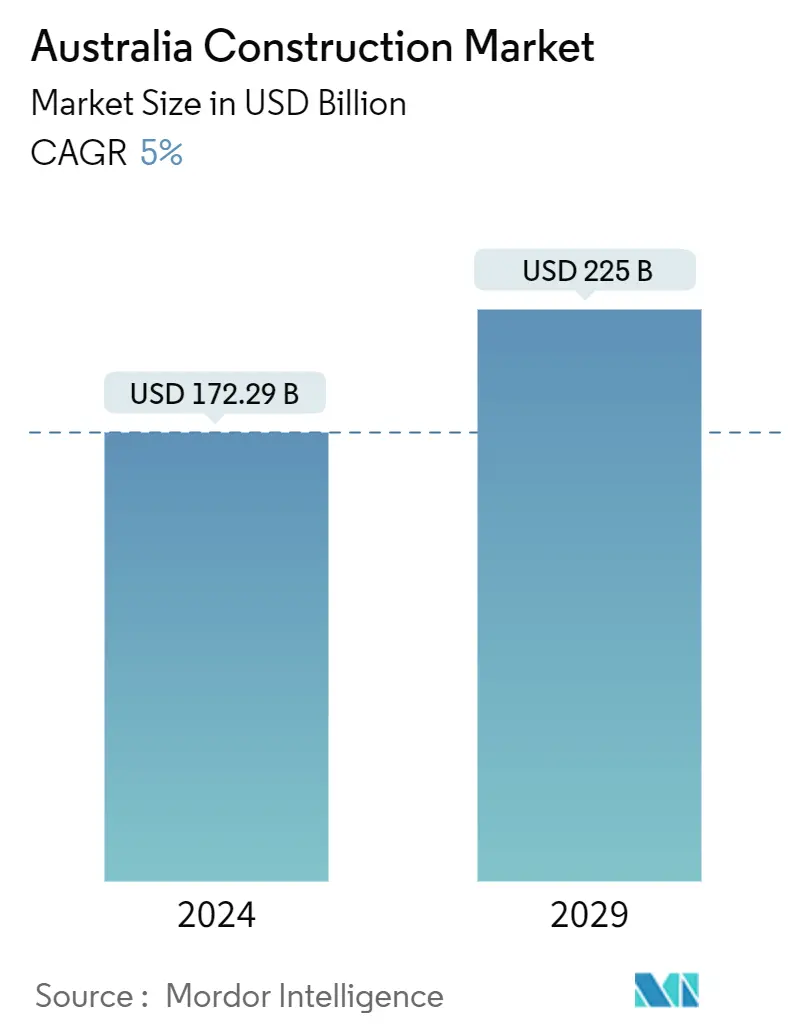Market Size of Australia Construction Industry

| Study Period | 2020 - 2029 |
| Base Year For Estimation | 2023 |
| Market Size (2024) | USD 172.29 Billion |
| Market Size (2029) | USD 225 Billion |
| CAGR (2024 - 2029) | 5.00 % |
| Market Concentration | Low |
Major Players
*Disclaimer: Major Players sorted in no particular order |
Australia Construction Market Analysis
The Australia Construction Market size is estimated at USD 172.29 billion in 2024, and is expected to reach USD 225 billion by 2029, growing at a CAGR of 5% during the forecast period (2024-2029).
The huge investment flowing in the industry is driving the market. Furthermore, the industry is being driven by technological innovation and demand for prefabricated buildings.
- The outlook for investment remains positive. A large pipeline of residential and non-residential projects is expected to sustain construction activity for at least the next year. However, the recent flow of data and information from the Bank's liaison program indicate that capacity constraints have intensified in some sectors, which will limit the pace of growth in construction activity for some time. The pipeline of private non-residential construction work yet to be done increased recently, reflecting additional commercial projects. By contrast, the outlook for dwelling investment has been downgraded. Demand for new detached dwellings is expected to be soft as a further decline in established housing prices and high construction costs reduce the incentive to build new dwellings. Prospects for higher-density residential projects are brighter, as rental vacancy rates in Sydney and Melbourne have declined and the population growth recovers following the reopening of the international border.
- The Australian construction industry generates nearly 360 billion in revenue (9% of the country's Gross Domestic Product (GDP)) and has a projected annual growth rate of 2.4%. As of November 2021, the construction industry employed approximately 1,143,600 people. It employs approximately one in 10 workers, and this constitutes 8.7% of the total workforce. According to the construction industry statistics for the five years to November 2021, employment in the industry increased by 7.3%. The Australian Industry and Skills Committee states that although employment declined in 2020 and 2021, projections indicate that it will reach 1,263,900 by 2025. However, more optimistic predictions indicate an employment growth of 6.8% by November 2025.
- The Australian government has a strong vision for developing smarter communities powered by cutting-edge technology solutions. Digital transformation has been placed at the heart of the government's economic strategy. New technologies in the construction industry are disrupting traditional models for planning, staffing, monitoring, and delivering projects as the physical world becomes increasingly digitized. Despite the obvious benefits, the construction industry is one of the slowest in the world to adopt new technologies and has had lower productivity gains compared to other sectors, such as manufacturing. Startups play an important role in digitizing the construction business. Investors are also interested in the possibilities they offer.
- The sudden arrival of new buildings is altering the skylines. These new constructions are partially a result of prefabricated construction marvels, which allow for the production of big components off-site, shipping them to the construction site, and assembling them more quickly than would be possible with traditional bricklaying or other methods. Prefabrication combines manufacturing and building, resulting in a solution that combines the advantages of lower labor costs with high-quality output because the majority of prefabricated structures are created off-site in a tightly regulated environment. The knock-on impact of prefabrication may result in reduced mortgages, more homeowners, and reasonably priced rents by minimizing the cost of labor, materials, and site hours.
Australia Construction Industry Segmentation
Civil construction is a subset of civil engineering, which is concerned with the design, construction, and maintenance of the physical and naturally built environment. The art of building bridges, dams, roads, airports, canals, and buildings is known as civil construction.
A complete background analysis of the Australia Construction Market, including the assessment of the economy and contribution of sectors in the economy, market overview, market size estimation for key segments, and emerging trends in the market segments, market dynamics, and geographical trends, and COVID-19 impact, is covered in the report. The Australia Construction Market is segmented by Sector (Residential, Commercial, Industrial, Infrastructure (Transportation), Energy, and Utilities). The report offers market size and forecasts for the Australia Construction market in value (USD) for all the above segments.
| By Sector | |
| Residential | |
| Commercial | |
| Industrial | |
| Infrastructure | |
| Energy and Utilities |
Australia Construction Market Size Summary
The Australian construction industry is poised for significant growth over the forecast period, driven by substantial investments and technological advancements. The market is experiencing a shift towards prefabricated buildings, which offer benefits such as reduced labor costs and high-quality output due to off-site manufacturing. This trend is supported by the government's vision of developing smarter communities through digital transformation, although the industry has been slow to adopt new technologies compared to sectors like manufacturing. The construction sector's contribution to the country's GDP is substantial, with commercial building activities playing a crucial role in its expansion. Despite challenges such as capacity constraints and fluctuating demand in the residential segment, the non-residential construction market continues to show promise, particularly in areas like transportation, health, and retail.
The competitive landscape of the Australian construction market is characterized by a few major players, including Lendlease Group and CIMIC Group, who are increasingly focusing on innovation and digitalization. Partnerships with technology firms and research institutions are fostering advancements in artificial intelligence and robotics, aimed at addressing industry challenges such as productivity and labor shortages. The market's potential for growth is further bolstered by government-led projects and the rising demand for cost-effective housing solutions, particularly in urban areas. As the industry navigates through past challenges, the integration of prefabricated systems is expected to enhance efficiency and sustainability, positioning the Australian construction sector for robust development in the coming years.
Australia Construction Market Size - Table of Contents
-
1. MARKET INSIGHTS
-
1.1 Current Economic and Construction Market Scenario
-
1.2 Technological Innovations in the Construction Sector
-
1.3 Construction Costs
-
1.4 Impact of Government Regulations and Initiatives on the Industry
-
1.5 Key Production, Consumption, Exports and Import Statistics of Construction Materials
-
1.6 Spotlight on Prefabricated Buildings Market in Australia
-
1.7 Insights on Key Distributors/Traders
-
1.8 Impact of COVID-19 on the market
-
-
2. MARKET SEGMENTATION
-
2.1 By Sector
-
2.1.1 Residential
-
2.1.2 Commercial
-
2.1.3 Industrial
-
2.1.4 Infrastructure
-
2.1.5 Energy and Utilities
-
-
Australia Construction Market Size FAQs
How big is the Australia Construction Market?
The Australia Construction Market size is expected to reach USD 172.29 billion in 2024 and grow at a CAGR of 5% to reach USD 225 billion by 2029.
What is the current Australia Construction Market size?
In 2024, the Australia Construction Market size is expected to reach USD 172.29 billion.

